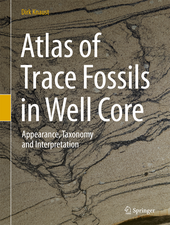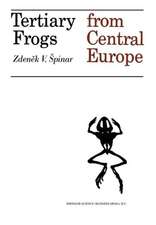The Argentina Continental Margin: A Potential Paleoclimatic-Paleoceanographic Archive for the Southern Ocean: SpringerBriefs in Earth System Sciences
Autor Roberto A. Violante, Cecilia Laprida, Natalia L. García Chaporien Limba Engleză Paperback – 31 mar 2017
As a result of this complexity in the regional processes in the framework of the broad hemispheric oceanographic-climatic conditioning factors, the ACM can be considered as a complete archive for the Southern Ocean.
Din seria SpringerBriefs in Earth System Sciences
-
 Preț: 379.09 lei
Preț: 379.09 lei -
 Preț: 260.95 lei
Preț: 260.95 lei -
 Preț: 424.71 lei
Preț: 424.71 lei -
 Preț: 378.54 lei
Preț: 378.54 lei -
 Preț: 380.07 lei
Preț: 380.07 lei -
 Preț: 376.22 lei
Preț: 376.22 lei -
 Preț: 377.57 lei
Preț: 377.57 lei -
 Preț: 379.48 lei
Preț: 379.48 lei -
 Preț: 379.09 lei
Preț: 379.09 lei -
 Preț: 377.35 lei
Preț: 377.35 lei -
 Preț: 379.09 lei
Preț: 379.09 lei -
 Preț: 259.57 lei
Preț: 259.57 lei -
 Preț: 376.80 lei
Preț: 376.80 lei -
 Preț: 377.73 lei
Preț: 377.73 lei -
 Preț: 379.86 lei
Preț: 379.86 lei -
 Preț: 381.00 lei
Preț: 381.00 lei -
 Preț: 140.77 lei
Preț: 140.77 lei -
 Preț: 380.07 lei
Preț: 380.07 lei -
 Preț: 262.47 lei
Preț: 262.47 lei -
 Preț: 377.18 lei
Preț: 377.18 lei -
 Preț: 260.56 lei
Preț: 260.56 lei -
 Preț: 376.22 lei
Preț: 376.22 lei -
 Preț: 377.18 lei
Preț: 377.18 lei -
 Preț: 378.12 lei
Preț: 378.12 lei -
 Preț: 379.09 lei
Preț: 379.09 lei -
 Preț: 376.59 lei
Preț: 376.59 lei -
 Preț: 375.23 lei
Preț: 375.23 lei -
 Preț: 376.04 lei
Preț: 376.04 lei -
 Preț: 380.07 lei
Preț: 380.07 lei -
 Preț: 443.58 lei
Preț: 443.58 lei -
 Preț: 384.48 lei
Preț: 384.48 lei -
 Preț: 377.95 lei
Preț: 377.95 lei -
 Preț: 376.59 lei
Preț: 376.59 lei -
 Preț: 350.18 lei
Preț: 350.18 lei -
 Preț: 379.68 lei
Preț: 379.68 lei -
 Preț: 378.71 lei
Preț: 378.71 lei -
 Preț: 378.12 lei
Preț: 378.12 lei -
 Preț: 376.96 lei
Preț: 376.96 lei -
 Preț: 377.35 lei
Preț: 377.35 lei -
 Preț: 374.30 lei
Preț: 374.30 lei -
 Preț: 377.73 lei
Preț: 377.73 lei -
 Preț: 378.34 lei
Preț: 378.34 lei -
 Preț: 378.54 lei
Preț: 378.54 lei -
 Preț: 412.89 lei
Preț: 412.89 lei -
 Preț: 375.62 lei
Preț: 375.62 lei -
 Preț: 341.97 lei
Preț: 341.97 lei -
 Preț: 379.09 lei
Preț: 379.09 lei -
 Preț: 375.23 lei
Preț: 375.23 lei -
 Preț: 377.35 lei
Preț: 377.35 lei
Preț: 348.79 lei
Nou
Puncte Express: 523
Preț estimativ în valută:
66.75€ • 69.43$ • 55.11£
66.75€ • 69.43$ • 55.11£
Carte tipărită la comandă
Livrare economică 10-16 aprilie
Preluare comenzi: 021 569.72.76
Specificații
ISBN-13: 9783319041957
ISBN-10: 3319041959
Pagini: 100
Ilustrații: XV, 117 p. 15 illus., 13 illus. in color.
Dimensiuni: 155 x 235 mm
Ediția:1st ed. 2017
Editura: Springer International Publishing
Colecția Springer
Seria SpringerBriefs in Earth System Sciences
Locul publicării:Cham, Switzerland
ISBN-10: 3319041959
Pagini: 100
Ilustrații: XV, 117 p. 15 illus., 13 illus. in color.
Dimensiuni: 155 x 235 mm
Ediția:1st ed. 2017
Editura: Springer International Publishing
Colecția Springer
Seria SpringerBriefs in Earth System Sciences
Locul publicării:Cham, Switzerland
Public țintă
ResearchCuprins
The Argentina Continental Margin (ACM).- Location in the context of the Southern Hemisphere, the southern tip of South America and Antarctica.- The ACM as an archive for paleoclimatic and paleoceanographic changes.- Local and regional processes: climate, oceanography, sea-level fluctuations, isostasy, tectonism, sediment supply, sedimentary processes.- Oceanographic Context: interaction between Antarctic and Equator water-masses.- Environments: continental shelf, slope, rise, ocean basin.- Sedimentary processes in each of them: along-shore and across-shore processes.- Effects of the sea-level fluctuations on the shelf.- Effects of the water-masses circulation on the slope and rise.- Turbiditic and contouritic processes.- Morphosedimentary features in each environment.- The significance of the ACM as a potential archive for understanding local and regional processes.
Notă biografică
Dr. Roberto Antonio Violante has a degree in Geology from the Faculty of Natural Sciences, University of La Plata, Argentina. Basic degree obtained in 1975. PhD obtained in 1988. Specialized in Coastal Geology at Florida State University, Tallahassee, Florida, USA.
He has been working at the Argentina Hydrographic Survey since 1975, in the division of Marine Geology and Geophysics (Department of Oceanography). He is presently a Principal Researcher, Projects Director and Chief of the Marine Geology Section. His main research interests are: marine, coastal and lacustrine geology; sedimentary process; seismic-stratigraphy; geomorphology; marine sedimentation (shelf-slope); contouritic and turbiditic processes.
He has been working at the Argentina Hydrographic Survey since 1975, in the division of Marine Geology and Geophysics (Department of Oceanography). He is presently a Principal Researcher, Projects Director and Chief of the Marine Geology Section. His main research interests are: marine, coastal and lacustrine geology; sedimentary process; seismic-stratigraphy; geomorphology; marine sedimentation (shelf-slope); contouritic and turbiditic processes.
Dr. Cecilia Laprida has adegree in Biology from the Faculty of Natural Sciences, University of Buenos Aires (Argentina), obtained in 1992, and a PhD degree in Biology obtained in 1998. Specialized in Micropaleontology, she presently acts as Professor of Paleobiology at the Ecology, Genetics and Evolution Department at Buenos Aires University, and Independent Researcher of the National Council of Scientific and Technical Research in the Institute of Andean Studies “Don Pablo Groeber” (UBA-CONICET). Her main research interests are foraminifera and ostracods as proxies for Late Quaternary climatic and environmental reconstructions in marine and continental settings.
Dr. Natalia García Chapori has a degree in Biology from the Faculty of Natural Sciences, University of Buenos Aires (Argentina), obtained in 2007, and a PhD degree in Geology obtained in 2013. Specialized in the Paleoceanography of the western South Atlantic during the Quaternary, she presently acts as Assistant Researcher of the National Council of Scientific and Technical Researchin the SACMa group of the Institute of Andean Studies “Don Pablo Groeber” (UBA-CONICET). Her main research interests are: paleocenographic and paleoclimatic reconstruction of the quaternary, foraminifera as environmental proxies; multivariate statistics as tool of environmental reconstruction.
Caracteristici
Includes supplementary material: sn.pub/extras









